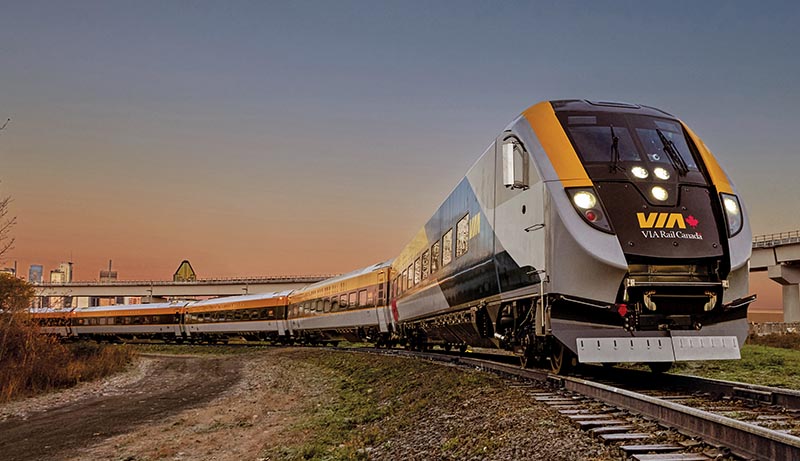 by Terry Johnson/photos as noted
by Terry Johnson/photos as noted
On November 30, 2021, in Ottawa, Ont., VIA Rail Canada officially unveiled the first train of its new Corridor fleet. The event was the culmination of almost five years of work by VIA, which was given permission by the Canadian government to start procurement of a new Corridor fleet in 2017, and by Siemens Mobility, which was awarded the contract in 2018.
The unveiling of the new trains also signaled the impending replacement of VIA’s long-serving LRC car fleet. The LRCs were introduced in the summer of 1981, and the cars are now a decade past the end of their originally anticipated service life. The last of VIA’s LRC locomotives was retired in 2001. The first of the new trains is expected to enter revenue service in late 2022 and should secure the future of inter-city passenger service in the Corridor for a generation.

ABOVE: Economy Class interiors feature 2+2 seating. Open parcel shelves replace the enclosed airline-style overhead luggage bins that VIA passengers are used to. —Terry Johnson
As part of the launch event, invited guests were able to tour one of VIA’s Siemens “Venture” trains for the first time, visiting the locomotive cab and one of the Economy Class cars. Because the first train is currently configured for testing, which commenced in December 2021 initially between Ottawa and Coteau, Que., not all of the cars were opened for viewing on this occasion and a few items such as the luggage towers were yet to be installed. That did not detract from the sleek vision of future Corridor services drawn up alongside the new high-level platform at VIA’s Ottawa station.
During the press conference, the question was asked whether acquiring new diesel trains really contributes to progress toward the Canadian government’s goal of achieving net-zero carbon emissions by 2050. The answer given was that yes, these new trains are significantly more efficient than their predecessors, with lower emissions of CO2 and other pollutants.

ABOVE: During the Siemens equipment’s first test trips in southwestern Ontario, SC42 2201 pauses with the train at St. Marys (between Kitchener and London) on April 14, 2022. The VIA station here (also served by recently extended GO Transit schedules) is a former Grand Trunk Railway and CN structure built in 1907. —Larry Broadbent
More significantly, by providing more seats, greater comfort, higher reliability, and hopefully more frequent services even in advance of the High Frequency Rail (HFR) project, the new trains will contribute to modal shift from road and air travel between cities along the Quebec City–Windsor Corridor, reducing emissions per passenger journey by up to 90 percent.
It was previously announced that the new HFR Corridor route will be electrified where it does not share tracks with freight, and an available electric or dual-mode version of the Siemens Venture trains is likely to be used on those services.
Full Bidirectional Operation
The cab cars are one of the most im-portant features of these new trains, allowing full bidirectional operation and saving time currently spent turning trains on wye tracks after each trip. The limited number of existing train consists that VIA has been able to deploy in bidirectional configurations have been very helpful in allowing VIA to support existing Corridor service frequencies with a reduced number of available LRC and HEP-1 cars. Having all 32 trains in the new fleet able to operate bidirectionally will create scope for additional service frequencies to meet the growth of demand for rail travel in the Corridor…


